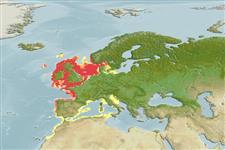Classification / Names
Common names from other countries
Main reference
Size / Weight / Age
Max length : 46.0 cm TL male/unsexed; (Ref. 7034); common length : 30.0 cm TL male/unsexed; (Ref. 1371); max. reported age: 4 years (Ref. 1371)
Length at first maturity
Lm 21.6, range 21 - 25 cm
Environment
Marine; brackish; benthopelagic; oceanodromous (Ref. 51243); depth range 30 - 100 m (Ref. 3663)
Climate / Range
Temperate, preferred 11°C (Ref. 107945); 62°N - 25°N, 19°W - 16°E
Distribution
Northeastern Atlantic: from Norway to Morocco incl. British Isles and offshore islands, and Skagerrak, and in the western Mediterranean Ref. 1371, 90172).
Countries | FAO areas | Ecosystems | Occurrences | Introductions
Short description
Dorsal
spines
(total): 0;
Anal
spines: 0. Chin barbel well developed. Pelvic fins with slightly elongated anterior rays. Body light brown dorsally, relatively tall, grayish on the sides becoming silvery ventrally, with four or five broad indistinct transverse bars on the sides; a dark blotch at the upper edge of the pectoral-fin base (Ref. 1371). Eye diameter as snout length. Anus lies below the middle of the first dorsal fin (Ref. 35388).
IUCN Red List Status (Ref. 115185)
Threat to humans
Harmless
Human uses
Fisheries: commercial; aquarium: public aquariums
More information
ReferencesAquacultureAquaculture profileStrainsGeneticsAllele frequenciesHeritabilityDiseasesProcessingMass conversion
Tools
Special reports
Download XML
Internet sources
Estimates of some properties based on models
Phylogenetic diversity index
PD50 = 0.5625 many relatives (e.g. carps) 0.5 - 2.0 few relatives (e.g. lungfishes)
Trophic Level
3.7 ±0.1 se; Based on diet studies.
Resilience
Medium, minimum population doubling time 1.4 - 4.4 years (K=0.2-0.4; tm=1-2; tmax=4; Fec=200,000)
Vulnerability
Moderate vulnerability (44 of 100)
Price category
